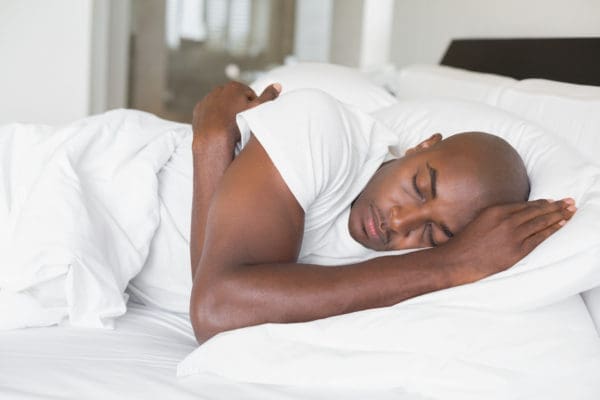Chronic pain can have a major effect on your overall quality of sleep. According to the National Sleep Association, pain is a major factor in creating sleep debt. People who suffer from chronic pain experience lower sleep quality and higher stress levels. We’ve got a look at the best sleeping positions for pain – including back, neck and shoulder pain – to help you catch your best zzz’s.
The Best (and Worst) Sleeping Positions for Pain
Sleep quality 101
Pain often rears its head at night, leading to restless nights and a lack of good sleep. If you’re living with chronic pain, you likely often struggle to find a comfortable sleeping position. The position you choose is critical: it can help to ease certain types of pain, make it easier to sleep and help prevent further aches.
If you consistently have trouble falling asleep or often wake up feeling sore, it might be time to change the way you’re sleeping. In general, it’s essential to:
- keep your limbs long to increase circulation and prevent cramping
- keep the spine straight and neutral to help prevent back and neck pain
Chronic pain in the back, neck, and shoulders may make you dread bedtime, but it is still possible to get a restorative snooze. From purchasing adjustable beds and firm mattresses to finding the best sleeping positions for pain, there are many strategies and remedies that you can try to improve your sleep hygiene.
Position #1: Sleeping on your back
Sleeping on your back is the best position for overall health according to the National Sleep Foundation.

When you sleep on your back, your weight is evenly distributed on your spine. This is important for reducing back pain. Additionally, your head, neck, and spine are in neutral positions. This helps to eliminate strain and reduces neck pain.
This is also the best sleeping position for those who struggle with acid reflux because it keeps your face turned upward and your head slightly elevated. This works to prevent acid from coming up through your digestive tract.
However, despite the obvious health benefits of sleeping on your back, it isn’t the ideal sleep position if you suffer from sleep apnea. The force of gravity that weighs down on your stomach and throat when you sleep on your back can cause your tongue to block your breathing tube, making snoring worse.
You can use the supine position if you want to sleep on your back. It entails resting on your back, but with your knees bent slightly upwards. You can place a small pillow just below the knees to help maintain the position.
Try this pillow for optimal relief in the supine position. The half-moon knee pillow is recommended by chiropractors, physical therapists, sports trainers, and doctors, as well as hypo-allergenic. In addition, it’s designed to enable proper spine and hip alignment!
- Amazon Rating: 4.5 stars, 813 reviews
Position #2: Sleeping on your side
Sleeping on your side is another ideal position for those who suffer from back or neck pain. Side sleepers have the benefit of an elongated spine alignment, which helps to reduce both back and neck pain. Additionally, this position keeps your airways open. This both reduces snoring and helps to prevent acid reflux.


If you do sleep on your side, your left side is ideal. Sleeping on the right side can constrict your rib cage and lungs and hinder blood circulation. Sleeping on your left side reduces acid reflux and promotes optimal blood flow, making it the preferable choice.
This “Contour Legacy Leg Pillow” is great for side sleepers. It positions you in your natural alignment, alleviating pressure points that often cause discomfort & pain.
- Amazon Rating:4.5 stars, 6,175 reviews
Position #3: Sleeping on your stomach
According to the National Sleep Foundation, sleeping on your stomach is the worst position for overall health. Sleeping on your stomach pulls your stomach and spine into the bed, placing pressure points on the curvature of your spine and strain on your back and neck. This position also cuts off circulation, which can lead to tingling or numbness in the limbs.

This “Belly Sleep Gel Infused Memory Foam Pillow” is perfect for stomach sleepers. At 2.5 inches thick, this pillow helps keep your head and neck in a neutral position. The pillow is also curved, making sure that the pressure placed on your head is uniform. This helps improve breathing and reduce pressure points.
- Amazon Rating: 4.5 stars, 132 reviews
Position #4: Sleeping in the fetal position
This is quite a common sleeping position. It helps to reduce snoring and can improve circulation.
However, the fetal position can also be constricting and is not the best for reducing joint or back pain. If you like to sleep in the fetal position but are worried about joint pain or morning soreness, stretch out throughout the night instead of pulling into a tight ball.

Try this Sleep Yoga Side Sleeper Pillow with Arm Support. It can help you reduce shoulder strain, better align your arm and shoulder, align your neck, and minimize slouching. The pillow provides a unique notch for your neck, as well as a resting place for your arm.
- Amazon Rating: 3.5 stars, 94 reviews
Pain management sleep tips
Before you start switching your nighttime schedule to incorporate the best sleeping positions for pain, it is important to first determine the cause. There are several causes for chronic back and neck pain such as spinal stenosis, osteoarthritis, degenerative disc disease, arthritis, pinched nerves or muscle strain.
For back pain, don’t forget:
- Sleeping on your side will take the pressure off of your back and ensures proper alignment of your spine.
- Stomach sleepers may feel pressure taken off of their backs, but if you want to try this position it’s best to have a firm pillow beneath your stomach. This helps to prevent your back from being forced to arch towards the stomach as a result of gravity.
For neck pain, don’t forget:
- Sleeping on your back is a more natural posture. However, this is only true if you do not also have back pain. You can also enhance the effectiveness of this sleep position by placing a rolled-up towel under your neck.
- Side sleeping is a common recommendation. Put a pillow between your knees for extra support. Also, avoid raising your arms under or over your head to ensure you do not put too much pressure on your shoulders and neck.
For shoulder pain, don’t forget:
- Avoid leaning all your weight on your shoulders while sleeping. The key to easing the pain is to ensure that your spine remains in a neutral position.
- Side sleeping is likely your best option. It can be challenging, so make sure to have one or more pillows under your shoulder.
- Rotate your shoulder slightly backward or forward.
- Avoid sleeping on one side for too long.
Back, shoulder and neck pain can easily keep you awake all night, but they don’t have to be a problem every night. Talk to your health care team about your sleep hygiene and possible underlying pain conditions. Get creative with your sleep routine and make choices that target your individual sleep needs.
What do you think are your best sleeping positions for pain?
What topics related to sleeping positions and pain would you like to see us explore?
Email us at info@painresource.com with your ideas.
Are you on Facebook?
Join our online community by clicking here.
Pain management starts and ends with health awareness and dedication. Click here to read more.




